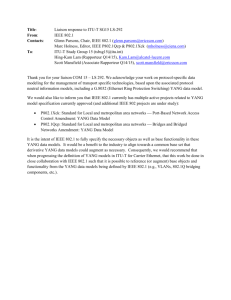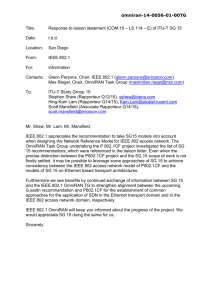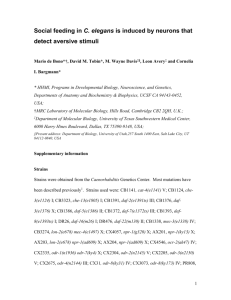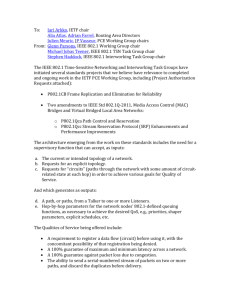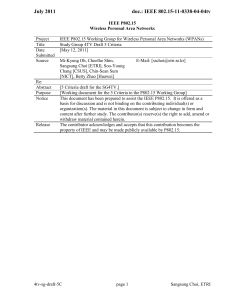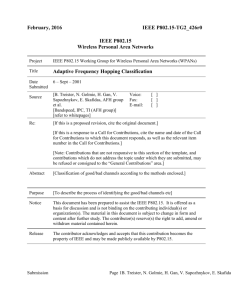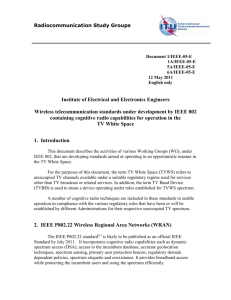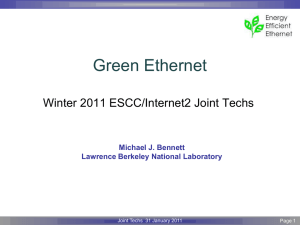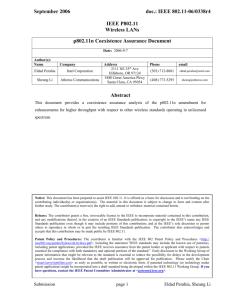3. p802.11n AWN to P802.15.1 IWN
advertisement
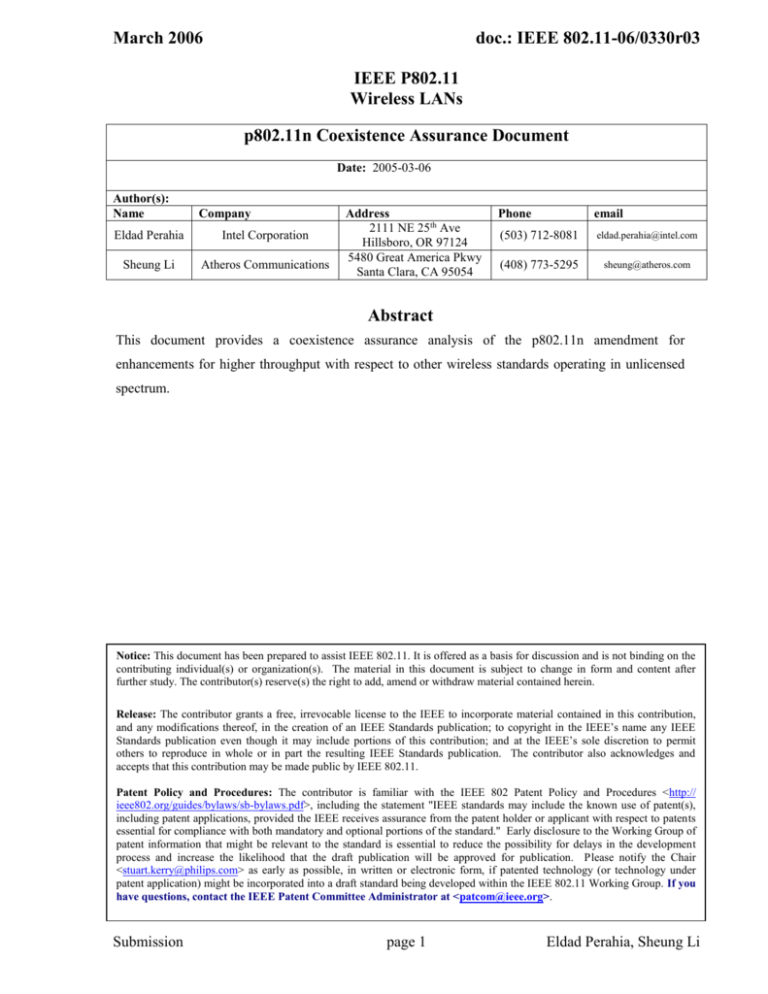
March 2006 doc.: IEEE 802.11-06/0330r03 IEEE P802.11 Wireless LANs p802.11n Coexistence Assurance Document Date: 2005-03-06 Author(s): Name Company Eldad Perahia Intel Corporation Sheung Li Atheros Communications Address 2111 NE 25th Ave Hillsboro, OR 97124 5480 Great America Pkwy Santa Clara, CA 95054 Phone email (503) 712-8081 eldad.perahia@intel.com (408) 773-5295 sheung@atheros.com Abstract This document provides a coexistence assurance analysis of the p802.11n amendment for enhancements for higher throughput with respect to other wireless standards operating in unlicensed spectrum. Notice: This document has been prepared to assist IEEE 802.11. It is offered as a basis for discussion and is not binding on the contributing individual(s) or organization(s). The material in this document is subject to change in form and content after further study. The contributor(s) reserve(s) the right to add, amend or withdraw material contained herein. Release: The contributor grants a free, irrevocable license to the IEEE to incorporate material contained in this contribution, and any modifications thereof, in the creation of an IEEE Standards publication; to copyright in the IEEE’s name any IEEE Standards publication even though it may include portions of this contribution; and at the IEEE’s sole discretion to permit others to reproduce in whole or in part the resulting IEEE Standards publication. The contributor also acknowledges and accepts that this contribution may be made public by IEEE 802.11. Patent Policy and Procedures: The contributor is familiar with the IEEE 802 Patent Policy and Procedures <http:// ieee802.org/guides/bylaws/sb-bylaws.pdf>, including the statement "IEEE standards may include the known use of patent(s), including patent applications, provided the IEEE receives assurance from the patent holder or applicant with respect to patents essential for compliance with both mandatory and optional portions of the standard." Early disclosure to the Working Group of patent information that might be relevant to the standard is essential to reduce the possibility for delays in the development process and increase the likelihood that the draft publication will be approved for publication. Please notify the Chair <stuart.kerry@philips.com> as early as possible, in written or electronic form, if patented technology (or technology under patent application) might be incorporated into a draft standard being developed within the IEEE 802.11 Working Group. If you have questions, contact the IEEE Patent Committee Administrator at <patcom@ieee.org>. Submission page 1 Eldad Perahia, Sheung Li March 2006 doc.: IEEE 802.11-06/0330r03 Table of Contents 1. 2. 3. 3.1. 3.2. 3.3. 4. 5. 5.1. 5.2. 6. 7. 7.1. 7.2. 7.3. 8. Introduction ..................................................................................................................................... 3 Scope of Analysis ............................................................................................................................ 3 p802.11n AWN to P802.15.1 IWN ................................................................................................. 4 Geometric Analysis ..................................................................................................................... 4 Temporal Analysis ...................................................................................................................... 9 Combined Geometric and Temporal Analysis .......................................................................... 17 p802.11n IWN to P802.15.1 AWN ............................................................................................... 18 p802.11n AWN to P802.16 AWN ................................................................................................. 19 Geometric Analysis ................................................................................................................... 19 Throughput Analysis ................................................................................................................. 20 p802.11n AWN to UWB IWN ...................................................................................................... 22 p802.11n AWN to Cordless Telephony IWN ............................................................................... 23 Geometric Analysis ................................................................................................................... 23 Temporal Analysis .................................................................................................................... 24 Combined Geometric and Temporal Analysis .......................................................................... 27 References ..................................................................................................................................... 28 Table of Figures Figure 1: Basic PHY geometric model ......................................................................................................... 4 Figure 2: AP - STA link budget .................................................................................................................. 5 Figure 3: PER curve for 20MHz, channel model B [6] ............................................................................... 6 Figure 4: PER curve for 40MHz, channel model B [6] ................................................................................ 7 Figure 5: Required separation between STA and interferer ......................................................................... 8 Figure 6: Typical p802.11n packet exchange with aggregation ................................................................... 9 Figure 7: 40MHz spectral plot .................................................................................................................... 10 Figure 8: Temporal collision ...................................................................................................................... 10 Figure 9: Frequency overlap ....................................................................................................................... 11 Figure 10: Impact of aggregate packet length and P802.15.1 utilization for 130Mbps, 20MHz mode ..... 13 Figure 11: Impact of aggregate packet length and P802.15.1 utilization for 6.5 Mbps, 20MHz mode ..... 14 Figure 12: Impact of aggregate packet length and P802.15.1 utilization for 270 Mbps, 40MHz mode .... 15 Figure 13: Impact of aggregate packet length and P802.15.1 utilization for 13.5 Mbps, 40MHz mode ... 16 Figure 14: p802.11n goodput ..................................................................................................................... 17 Figure 15: Required separation between STA and P802.16 basestation interferer .................................... 20 Figure 16: p802.11n goodput with P802.16 basestation interferer ............................................................. 21 Figure 17: Required separation between STA and interferer for cordless telephony ................................. 24 Figure 18: Impact of aggregate packet length and WDCT utilization for 130Mbps, 20MHz mode .......... 25 Figure 19: of aggregate packet length and WDCT utilization for 6.5 Mbps, 20MHz mode ...................... 25 Figure 20: Impact of aggregate packet length and WDCT utilization for 270 Mbps, 40MHz mode ......... 26 Figure 21: Impact of aggregate packet length and WDCT utilization for 13.5 Mbps, 40MHz mode ........ 26 Figure 22: p802.11n goodput with WDCT interferer ................................................................................. 27 Submission page 2 Eldad Perahia, Sheung Li March 2006 doc.: IEEE 802.11-06/0330r03 1. Introduction In accordance with Procedure 22 of the IEEE 802 Policies and Procedures, project 802.11n (p802.11n), enhancements for higher throughput to the IEEE 802.11 (2005) standard has produced a coexistence assurance (CA) document in partial fulfilment of the requirements for working group letter ballot and sponsor ballot. While the preparation of this document is not strictly mandated in the five criteria for p802.11n, the timeline for development and delivery of this amendment led to an advisory at the IEEE 802.19 July 2005 plenary meeting to create such a CA document. This CA document addresses coexistence with relevant approved 802 and other wireless standards specifying devices for unlicensed operation in the 2.400 – 2.483 GHz (2.4 GHz) and 5.150 – 5.850 GHz (5 GHz) bands in accordance with the analytic CA models presented in document 19-040038r1. 2. Scope of Analysis The principal focus of this analysis is geometric and temporal interferer modelling. IEEE P802.15.1 personal area networks, IEEE P802.16 broadband wireless access networks, and cordless telephony systems have been addressed. The most detailed analysis is on IEEE P802.15.1 personal area network operation in the 2.4 GHz band. Geometric and simple interferer modelling is provided for IEEE P802.16. p802.16h will define and provide co-existence mechanisms for IEEE P802.16 broadband wireless access networks in unlicensed bands of operation, but is in the call for contributions stage at this time. Per Procedure 22, coexistence shall be addressed with respect to relevant approved 802 standards, so CA analysis with respect to p802.16h is deferred until it is further developed. The extensive use of various proprietary transmission methods for 2.4 and 5.8 GHz cordless telephony, and the closed nature of these protocols make complete CA modelling with respect to this class of products impractical. However, an analysis based on basic parameters of one widely available system is presented. Ultra wideband systems under various standards cover a wide frequency range. However, at this time of this document’s development, only band group 1 (3.1 – 4.7 GHz) is defined as mandatory for ultra wideband operation, so there is no overlap with p802.11n modes of operation. Submission page 3 Eldad Perahia, Sheung Li March 2006 doc.: IEEE 802.11-06/0330r03 3. p802.11n AWN to P802.15.1 IWN A PHY interference model with a p802.11n affected wireless network (AWN) and a P802.15.1 network as the interfering wireless network (IWN) will be presented. A geometric analysis will demonstrate the necessary separation between AWN and IWN to avoid packet collisions. This is followed by a temporal packet collision analysis, in which we determine probability of the AWN and IWN in close proximity transmitting at coincidental times and frequencies. And last, the geometric and temporal packet collision analysis is combined to illustrate the overall throughput of the AWN as a function of location of the IWN. 3.1. Geometric Analysis The basic PHY geometric model is given by a STA communicating with an AP while simultaneously a nearby P802.15.1 device is transmitting causing interference to the STA. This is illustrated below. Interference 11n link Figure 1: Basic PHY geometric model We initially assume with pure geometric analysis complete overlap of transmission of AP-STA and interference-STA in time and frequency. Our goal is to determine the separation necessary between IWN device and STA to completely avoid interference. We define an “interference free” link as one that achieves a PER of 1%. To perform this analysis, we first specify the separation between the STA and AP. The separation between STA and AP sets the received signal level, and therefore the SNR of the link. An example of this analysis is given in the link budget below: Submission page 4 Eldad Perahia, Sheung Li March 2006 doc.: IEEE 802.11-06/0330r03 11n Link Tx Power Tx antenna gain pathloss frequency distance breakpoint shadow fading before breakpoint shadow fading after breakpoint free space total loss dBm dBi 17 2 GHz m m 2.4 20 5 3 dB dB 4 54.0 79.1 Rx antenna gain RSSI Noise Power NF BW total dBi dBm 2 -58.1 dB MHz dBm 6 20 -95.0 Required C/(N+I) dB Allowable Receive Interference power dBm -70.1 Interferer Tx Power Tx antenna gain Pathloss separation from STA dBm dBi dB m 0 2 74.1 18.7 12 Figure 2: AP - STA link budget In the above example, the separation between the STA and AP is 20m. This results in a total pathloss of 79 dB, based on the pathloss and shadow fading model in [7]. This combined with the EIRP and receiver antenna gain results in a RSSI of -58dBm. RSSI PT AT PL SF AR PT : Transmit power AT , AR : Transmit or receive antenna gain PL : Path loss SF : Shadow fading With a noise figure of 6 dB and a noise bandwidth of 20MHz, the thermal noise power is -95dBm. Submission page 5 Eldad Perahia, Sheung Li March 2006 doc.: IEEE 802.11-06/0330r03 N kTB F k : Boltzman' s constant T : Noise temperatu re B : Bandwidth F : noise figure We then specify the target MCS for the STA-AP link. From the target MCS, the required SNR at a PER equal to 1% can be derived. The figures below illustrate PHY simulation results for MCS 0, 7, and 15 for 20 and 40MHz. 1 Avg. PER 0.1 MCS0, 1x2 MCS7, 1x2 MCS12, 2x2 MCS13, 2x2 MCS15, 2x2 MCS15, 2x3 0.01 0.001 0 5 10 15 20 25 Avg. SNR 30 35 40 Figure 3: PER curve for 20MHz, channel model B [6] Submission page 6 Eldad Perahia, Sheung Li March 2006 doc.: IEEE 802.11-06/0330r03 1 Avg. PER 0.1 MCS32, 1x2 MCS7, 1x2 MCS12, 2x2 MCS13, 2x2 MCS15, 2x2 MCS15, 2x3 0.01 0.001 0 5 10 15 20 25 Avg. SNR 30 35 40 Figure 4: PER curve for 40MHz, channel model B [6] The required SNR at 1% PER is given in the table below: MCS 0 32 7 15 BW (MHz) 20 40 20 40 20 40 Required SNR (dB) 12 9 31 29 35.5 34.5 For the example in Figure 2, we use MCS 0 with a required SNR of 12dB. For simplicity, we assume a broadband noise-like interferer. Therefore, the required SNR equals the required SINR. (This can be updated later based on simulations with more accurate interference model. The necessary simulations entail an 11n receiver with an 11n transmitter and a narrowband P802.15.1-like transmitting interferer. The 11n transmitter/receiver link is set at a target SNR. The interferer power is increased to sweep a C/I range.) With the RSSI, noise power, and required SINR, the allowable level of interference can be derived as follows: Submission page 7 Eldad Perahia, Sheung Li March 2006 doc.: IEEE 802.11-06/0330r03 Int RSSI N SINRreq The resulting maximum allowable interference is -70dBm. The minimum pathloss between the interferer and the STA is derived as follows: PLI ( Int AR SFI AT , I PT , I ) PT , I : Interferer transmit power AR : STA receive antenna gain AT , I : Interferer transmit antenna gain SFI : Shadow fading on the interferer - STA link with the allowable pathloss equaling 74dB. Since the pathloss equation is a function of range, we invert the pathloss equation to derive the necessary separation between the interferer and STA. In this example the separation is 18.7m. The above example derived the interferer – STA separation based on a specific STA – AP separation and MCS. The following figure expands the analysis to span a range of separation between STA – AP for MCS 0, 7, and 15 (20MHz). Interferer - STA separation (m) 20MHz; Channel Model B 140 1x2, MCS 0 120 1x2, MCS 7 100 2x3, MCS 15 80 60 40 20 0 0 10 20 30 40 50 60 STA - AP separation (m) Figure 5: Required separation between STA and interferer Submission page 8 Eldad Perahia, Sheung Li March 2006 doc.: IEEE 802.11-06/0330r03 As illustrated for each MCS, the required interferer – STA separation for collision free performance is calculated based on the corresponding STA – AP separation. As the STA – AP separation increases, the required interferer – STA separation increases. And with higher MSC, the sensitivity to interference increases resulting in larger required separation between interferer and STA. 3.2. Temporal Analysis In the previous section, geometric analysis assumed complete overlap of transmission of AP-STA and interference-STA in time and frequency. In this section we will investigate the probability of overlap based on analysis by Ennis 1998[3] and Zyren 1998[5]. We begin by highlighting the two new features in p802.11n that will most impact time and frequency properties of a p802.11n transmission. In order to increase efficiency, aggregation is used to increase packet lengths. A typical p802.11n packet exchange with aggregation and block ACK is Contention Period illustrated in the figure below. STA A STA B TXOP RTS Data Data Data Data CTS BA = PHY Preamble Figure 6: Typical p802.11n packet exchange with aggregation Longer packet lengths will lead to more time overlap with P802.15.1 interferers. A second feature in p802.11n is 40MHz channels, for more than double increase in PHY data rate. Submission page 9 Eldad Perahia, Sheung Li March 2006 doc.: IEEE 802.11-06/0330r03 40 MHz HT ( HT-LTF and HT-Data) 25 20 15 10 Power (dB) 5 0 -5 -10 -15 -20 -25 -30 -20 -15 -10 -5 0 Frequency (MHz) 5 10 15 20 Figure 7: 40MHz spectral plot Occupying double the bandwidth, a 40 MHz p802.11n transmission will be more susceptible to P802.15.1 frequency hops. A temporal collision occurs when neighboring AWN and IWN devices transmit packets which overlap in time. The figure below illustrates a P802.15.1 packet stream overlapping with a p802.11n aggregated packet. 625us BT packets 366us Time 11n packet Data Data Data Data Figure 8: Temporal collision Since P802.15.1 is a frequency hopped system, a packet collision only occurs if the frequency hop coincides with the p802.11n channel. This is illustrated in the figure below. Submission page 10 Eldad Perahia, Sheung Li March 2006 doc.: IEEE 802.11-06/0330r03 Out-of-band BT interferer In-band BT interferer 11n Band Frequency Figure 9: Frequency overlap To calculate the probability of a collision, the joint probability of a temporal and frequency overlap must be computed. As a first step, we determine the number of P802.15.1 packets would overlap with the p802.11n aggregated packet, and the probability of such an event occurring. This follows the derivation in Zyren 1998[5]. N int( L11n / T ) if rem ( L11n , LBT ) T LBT N with probabilit y of N 1 with probabilit y of Poverlap T LBT rem ( L11n , LBT ) LBT 1 Poverlap else N 2 with probabilit y of N 1 Poverlap with probabilit y of rem ( L11n , LBT ) (T LBT ) LBT 1 Poverlap end T : P802.15.1 dwell period (625 sec) L11n :11n packet tim e on air LBT : P802.15.1 packet tim e on air (359 sec) Next, we determine the probability of an overlap in frequency, Pf . 20 / 79 for 20MHz Pf 40/79 for 40MHz The joint probability is given by the following: Submission page 11 Eldad Perahia, Sheung Li March 2006 doc.: IEEE 802.11-06/0330r03 if rem ( L11n , LBT ) T LBT Pno collision Poverlap 1 Pf else Pno collision Poverlap 1 Pf 1 P N overlap N 2 1 P N 1 f 1 Poverlap 1 Pf N 1 end Pcollision 1 Pno collision Individual P802.15.1 devices do not typically occupy all time slots. For all time slots to be occupied, a number of P802.15.1 devices must be active in a P802.15.1 picocell. The impact of partial utilization (or occupancy) within a P802.15.1 picocell is accommodated by multiplying the above collision probability by the picocell’s percentage utilization. Given the probability of a collision, we need to determine the impact on system performance. Assume a collision causes a packet error. This will necessitate a retransmission, reducing throughput. The average time on air of a p802.11n aggregated packet exchange during a TxOp is: DIFS + Avg backoff time + RTS + SIFS + CTS + SIFS + 11n Aggregated Packet + SIFS + BA where the p802.11n aggregated packet time is: Legacy Preamble + HT preamble + Data + Data + … Throughput with no collisions with P802.15.1 packets or other sources of packet errors is given by: Information bits / Time on air where information bits are defined as only those conveyed during the data portion of the aggregate. Throughput with collision with P802.15.1 packets and retransmission of entire aggregate is derived as follows (this can be refined for retransmission of just the data segment which was lost): Throughput B 1 T 1 P collision T : Time on time B : Informatio n bits The following four figures illustrate the impact of aggregate packet length and P802.15.1 utilization on p802.11n throughput. The curves with P802.15.1 utilization equal to 0 (noted by blue curve with label “BT occup = 0%”) illustrates throughput with no collisions. This demonstrates the dramatic improvement in efficiency derived from aggregation. However as the P802.15.1 utilization increases to Submission page 12 Eldad Perahia, Sheung Li March 2006 doc.: IEEE 802.11-06/0330r03 100%, the higher the likelihood of a temporal overlap and a collision with longer packet lengths. With 40MHz, this effect is even more dramatic with double the probability of a P802.15.1 device hopping inband. With very low PHY data rates the effect is less noticeable since individual data segments occupy so much time on air that there is little opportunity to aggregate many packets with typical TxOp lengths. PHY Data Rate = 130.0 Mbps; BW = 20 MHz 120 BT occup = 0% 10% 50% 100% 11n Goodput (Mbps) 100 80 60 40 20 0 0 5 10 30 25 20 15 Aggregate Packet Length (kBytes) 35 40 45 Figure 10: Impact of aggregate packet length and P802.15.1 utilization for 130Mbps, 20MHz mode Submission page 13 Eldad Perahia, Sheung Li March 2006 doc.: IEEE 802.11-06/0330r03 PHY Data Rate = 6.5 Mbps; BW = 20 MHz 6 5.5 11n Goodput (Mbps) 5 BT occup = 0% 10% 50% 100% 4.5 4 3.5 3 2.5 2 1.5 1 1.1 1.2 1.3 1.4 1.5 1.6 1.7 Aggregate Packet Length (kBytes) 1.8 1.9 2 Figure 11: Impact of aggregate packet length and P802.15.1 utilization for 6.5 Mbps, 20MHz mode Submission page 14 Eldad Perahia, Sheung Li March 2006 doc.: IEEE 802.11-06/0330r03 PHY Data Rate = 270.0 Mbps; BW = 40 MHz 250 11n Goodput (Mbps) 200 BT occup = 0% 10% 50% 100% 150 100 50 0 0 10 20 30 40 50 60 Aggregate Packet Length (kBytes) 70 80 90 Figure 12: Impact of aggregate packet length and P802.15.1 utilization for 270 Mbps, 40MHz mode Submission page 15 Eldad Perahia, Sheung Li March 2006 doc.: IEEE 802.11-06/0330r03 PHY Data Rate = 13.5 Mbps; BW = 40 MHz 14 12 11n Goodput (Mbps) 10 BT occup = 0% 10% 50% 100% 8 6 4 2 0 1 1.5 2 2.5 3 Aggregate Packet Length (kBytes) 3.5 4 Figure 13: Impact of aggregate packet length and P802.15.1 utilization for 13.5 Mbps, 40MHz mode As a final note on temporal and frequency overlap analysis, we address the issue of adaptive frequency hopping (AFH) in P802.15.1. AFH changes the hopping pattern of the P802.15.1 devices. The AFH enabled P802.15.1 devices measure the interference on individual 1 MHz channels. The P802.15.1 devices can then restrict its hopping pattern to skip channels with interference. The hopping pattern can be reduced to a minimum of 20 hops. The benefit of AFH is subject to the ability to accurately measure interference in the channel. In addition, the efficacy of AFH depends on the overlap between WLAN cells and the location of the P802.15.1 and p802.11n devices. Consider a three cell/AP p802.11n system with each occupying one of channels 1, 6, and 11. At the triple point between the three cells, fairly equal power levels will be received by P802.15.1 devices on each channel. It will be difficult for a P802.15.1 device to select channels to skip. This is further exacerbated by a p802.11n system utilizing 40MHz channels Obviously AFH will improve performance in many situations. The analysis presented here, without considering AFH, can be considered a conservative estimate of coexistence between these systems. Submission page 16 Eldad Perahia, Sheung Li March 2006 doc.: IEEE 802.11-06/0330r03 3.3. Combined Geometric and Temporal Analysis Geometric and temporal analysis can be combined to provide insight into the impact of STA – interferer separation on throughput in an interference limited environment. Figure 14 illustrates the throughput with MCS 0, 7, and 15 as the separation between the STA and interferer increases. The results are based on an aggregate filling up a 1.5msec TxOP. The P802.15.1 occupancy is assumed to be 50%. The C/N level is 40dB, creating an interference limited environment. Moderate throughputs are achieved with small separation given a reasonable length aggregate and P802.15.1 occupancy. As expected, as the separation increases between the STA and interferer, the throughput increases. C/N = 40dB 120 11n Goodput (Mbps) 100 MCS 0, 1x2 MCS 7, 1x2 MCS 15, 2x3 80 60 40 20 0 0 20 40 60 80 100 120 STA - Interferer Separation (m) Figure 14: p802.11n goodput The following steps were taken to derive the curves for throughput as a function of STA – interferer separation in Figure 14. As a first step, in the geometric analysis of Section 3.1, the STA – AP separation is set small enough to achieve a C/N of 40dB to create an interference limited environment. We sweep the achieved SINR and calculate a range of C/I values with a C/N of 40dB. The STA – AP separation Submission page 17 Eldad Perahia, Sheung Li March 2006 doc.: IEEE 802.11-06/0330r03 sets the carrier level, from which the interference level is calculated. Using the pathloss equation, the separation is derived from each interference level giving the x-axis values in Figure 14. As a second step, we begin again with the SINR values. These are converted to a range of PER values from the waterfall curves for each MSC. To compute the joint probability of a packet error, the PER values are multiplied by the temporal probability of collision and the P802.15.1 percent occupancy. The probability of collision is derived based on the p802.11n aggregate packet length. Finally, the throughput is calculated with the joint probability of a packet error to determine the reduction from retransmissions as in Section 3.2. 4. p802.11n IWN to P802.15.1 AWN As included by reference in Ennis 1998[3] and Zyren 1998[5], the incidence of a wideband P802.11 network interfering with a fast frequency hopping narrowband P802.15.1 network will be extremely low. There are no amendments in p802.11n that should affect this situation or the prior analysis. Submission page 18 Eldad Perahia, Sheung Li March 2006 doc.: IEEE 802.11-06/0330r03 5. p802.11n AWN to P802.16 AWN IEEE P802.16-2004 enables broadband wireless access in license-exempt bands below 11GHz. In the 5GHz band, the channelization is 10 and 20MHz on 5MHz spacing. Certain modes utilitize OFDM for transmission. Such an interference source will appear broadband noise like to a p802.11n IWN. In the licensed exempt bands, time division duplexing is mandated. For an initial conservative analysis, we assume a continuous downstream transmission from a P802.16 basestation. We also assume complete overlap in frequency band and channel bandwidth. In 5GHz band, the FCC regulatory requirements for power limits are as follows: Frequency Band (GHz) Maximum Conducted Output Power Maximum Antenna Gain w/o Reduction in Output power 5.150 – 5.250 Min(50mW, 6dBi 4dBm+10log10(BW_MHz) 5.250 – 5.350 5.470 – 5.725 Min(250mW, 6dBi 11dBm+10log10(BW_MHz) 5.725-5.850 Min(1000mW, 6dBi 17dBm+10log10(BW_MHz) Therefore, the maximum allowable EIRP in 5GHz is 30dBm in the 5.8GHz band. We shall assume that the P802.16 basestation is transmitting with the maximum allowable EIRP. Under the CEPT regulatory domain, there are similar transmit power limits for the frequencies below 5.725 GHz which effectively preclude P802.16 operation. 5.725 – 5.850 GHz under current CEPT rules also precludes P802.16 operation based on its allocation for unspecified short range devices. License-exempt regulatory requirements under Japan MIC and Republic of Korea MIC are similar to CEPT with respect to P802.16 operation. Other regulatory domains permitting 5.725 – 5.850 GHz license exempt operation such as Australia and Canada do so with ISM power levels similar to FCC regulations, so the analysis following does apply to them. 5.1. Geometric Analysis The geometric analysis follows the same methodology as outlined in Section 3.1. Link budget parameters are modified according to the assumptions in previous section. The figure below illustrates the necessary separation between a P802.16 basestation interferer and a STA as a function of STA – AP separation and MCS for 20MHz operation. Submission page 19 Eldad Perahia, Sheung Li March 2006 doc.: IEEE 802.11-06/0330r03 20MHz; Channel Model B Interferer - STA separation (m) 1000 900 1x2, MCS 0 800 1x2, MCS 7 700 2x3, MCS 15 600 500 400 300 200 100 0 0 10 20 30 40 50 60 STA - AP separation (m) Figure 15: Required separation between STA and P802.16 basestation interferer As can be seen from the above figure, a large separation between STA and interferer is required in the presence of a high power interferer. The larger the STA – AP separation, the more sensitive to degradation from interference. 5.2. Throughput Analysis We follow the analysis outlined in Section 3.3 to calculate throughput as a function of STA – interferer separation. As before, STA –interferer separation is derived from SINR with the C/N set to 40dB, creating an interference limited environment. Unlike P802.15.1, the temporal probability of collision is set to 1 and the percent occupancy of a fully active P802.16 basestation is assumed to be 100%. Packet error is derived from SINR, which is used to compute throughput degraded by retransmissions. Submission page 20 Eldad Perahia, Sheung Li March 2006 doc.: IEEE 802.11-06/0330r03 C/N = 40dB 120 11n Goodput (Mbps) 100 MCS 0, 1x2 MCS 7, 1x2 MCS 15, 2x3 80 60 40 20 0 0 200 400 600 STA - Interferer Separation (m) Figure 16: p802.11n goodput with P802.16 basestation interferer As the separation between STA and interferer decreases, the throughput reduces to zero. The higher MCS’s require larger separation between the STA and interferer. For MCS 15, a separation of 400m is required for unimpaired performance. The results would be improved by more accurate modelling of the time division duplexing mechanism employed by P802.16 to provide a better estimate of temporal overlap. In addition, p802.16h is developing coexistence mechanisms for license-exempt bands which will further improve coexistence between p802.11n and P802.16. Submission page 21 Eldad Perahia, Sheung Li March 2006 doc.: IEEE 802.11-06/0330r03 6. p802.11n AWN to UWB IWN At least two industry consortiums have emerged in area of UWB WPAN based on two technologies: OFDM and DS. The specifications for these consortiums should be similar to submissions in p802.15.3a. The OFDM proposal outlines the band plan in [9, Section 1.4.1.2]. The spectrum within the band 3.1 – 10.6 GHz is divided up in to five band groups: (1) 3.1-4.7 GHz (2) 4.7-6.3 GHz (3) 6.3-7.9 GHz (4) 7.9-9.5 GHz and (5) 9.5-10.6 GHz. The proposal goes on to state that band group one is mandatory. The remaining band groups are reserved for future use. A recent update to the DS proposal in [10, slide 4] describes the operating bands for the DS-UWB system. Each piconet operates in one of two bands: 3.1 – 4.9 GHz (required) and 6.2 – 9.7 GHz (optional). Neither system has mandatory bands of operation within the 2.4 or 5 GHz operating bands of p802.11n. Submission page 22 Eldad Perahia, Sheung Li March 2006 doc.: IEEE 802.11-06/0330r03 7. p802.11n AWN to Cordless Telephony IWN Many cordless technologies have emerged in 2.4 and 5GHz involving both analog and digital techniques. Proprietary systems emerged in the US, whereas various standards were developed in Europe. Digital techniques are typically based on either DSSS or FHSS. Due to the broad range of implementations, interference from European standardized systems as outlined in [11] will be analyzed to determine the impact to a p802.11n AWN. As described in [11], these standardized cordless telephone systems are FHSS-based with 95 channels, 864 kHz spacing, and 800 kHz typical bandwidth. The hop set is comprised of 75 channels, 20 channels are kept in reserve. They are TDD systems with a 10msec frame. The frame is divided into eight 1.25 msec time slots. The first four time slots are used by handsets to receive transmissions from the base; the second four time slots are used by the handsets to transmit to the base. The system can support up to four handsets, each utilizing a pair of slots. In addition, the power limit is 1 Watt; however 250mWatt is more typical and will be used in the analysis. Standardized cordless telephone systems are thus conceptually very similar to P802.15.1, and the analysis in Section 3 can be modified to their specific parameters. We will apply the analysis to the 2.4GHz band, but it will equally apply to cordless phones operation in the 5.8GHz band, and proprietary frequency hopping cordless telephones with comparable physical parameters. 7.1. Geometric Analysis Following the steps in Section 3.1, we derive the interferer – STA separation based on a specific STA – AP separation and MCS. The primary difference is in Section 3.1 the interferer transmit power was 0dBm, and for cordless telephony this analysis uses 24dBm. The results are illustrated in the figure below. As expected with the increase in interferer transmit power, the required separation drastically increases. Submission page 23 Eldad Perahia, Sheung Li March 2006 doc.: IEEE 802.11-06/0330r03 20MHz; Channel Model B Interferer - STA separation (m) 200 180 160 140 120 100 1x2, MCS 0 80 1x2, MCS 7 2x3, MCS 15 60 40 20 0 0 5 10 15 20 25 30 35 40 STA - AP separation (m) Figure 17: Required separation between STA and interferer for cordless telephony 7.2. Temporal Analysis The analysis in Section 3.2 is repeated for cordless telephony. The slot size is modified from 625usec to 1.25msec. The P802.15.1 signal only occupies 366 usec of the slot. We currently have no information on how much of the slot the cordless telephone signal occupies. As a conservative estimate, we will assume the entire slot is occupied. The results will be updated when actual parameters become available. Furthermore, P802.15.1 hops over 79 channels, the cordless telephone hops over 75 channels. The following four figures illustrate the impact of aggregate packet length and cordless telephone utilization on p802.11n throughput. The results are similar to P802.15.1 since the hoping and slot sizes are similar to those of standardized cordless telephones. Submission page 24 Eldad Perahia, Sheung Li March 2006 doc.: IEEE 802.11-06/0330r03 PHY Data Rate = 130.0 Mbps; BW = 20 MHz 120 11n Goodput (Mbps) 100 80 60 40 WDCT occup = 0% 10% 50% 100% 20 0 0 5 10 15 20 25 30 Aggregate Packet Length (kBytes) 35 40 45 Figure 18: Impact of aggregate packet length and phone utilization for 130Mbps, 20MHz mode PHY Data Rate = 6.5 Mbps; BW = 20 MHz 6 5.5 11n Goodput (Mbps) 5 WDCT occup = 0% 10% 50% 100% 4.5 4 3.5 3 2.5 2 1 1.1 1.2 1.3 1.4 1.5 1.6 1.7 Aggregate Packet Length (kBytes) 1.8 1.9 2 Figure 19: of aggregate packet length and phone utilization for 6.5 Mbps, 20MHz mode Submission page 25 Eldad Perahia, Sheung Li March 2006 doc.: IEEE 802.11-06/0330r03 PHY Data Rate = 270.0 Mbps; BW = 40 MHz 250 11n Goodput (Mbps) 200 WDCT occup = 0% 10% 50% 100% 150 100 50 0 0 10 20 30 40 50 60 Aggregate Packet Length (kBytes) 70 80 90 Figure 20: Impact of aggregate packet length and phone utilization for 270 Mbps, 40MHz mode PHY Data Rate = 13.5 Mbps; BW = 40 MHz 14 12 11n Goodput (Mbps) 10 8 6 WDCT occup = 0% 10% 50% 100% 4 2 0 1 1.5 2 2.5 3 Aggregate Packet Length (kBytes) 3.5 4 Figure 21: Impact of aggregate packet length and phone utilization for 13.5 Mbps, 40MHz mode Submission page 26 Eldad Perahia, Sheung Li March 2006 doc.: IEEE 802.11-06/0330r03 7.3. Combined Geometric and Temporal Analysis Following the analysis of Section 3.3, the geometric and temporal analysis of Sections 7.1 and 7.2 is combined to illustrate the impact of STA – interferer separation on throughput in a cordless telephone interference limited environment. As in Section 3.3, the results are based on an aggregate filling up a 1.5msec TxOP. The cordless telephone occupancy is assumed to be 50%. The C/N level is 40dB, creating an interference limited environment. Figure 22 illustrates the throughput with MCS 0, 7, and 15 as the separation between the STA and interferer increases. With moderate length aggregate and cordless telephone occupancy, reasonable throughputs are achieved with small separation. However, to achieve higher throughputs, much larger STA – interferer separation is required with cordless telephones than with P802.15.1 due to much higher interferer transmit power. C/N = 40dB 120 11n Goodput (Mbps) 100 MCS 0, 1x2 MCS 7, 1x2 MCS 15, 2x3 80 60 40 20 0 0 100 200 300 400 STA - Interferer Separation (m) Figure 22: p802.11n goodput with cordless telephone interferer Submission page 27 Eldad Perahia, Sheung Li March 2006 doc.: IEEE 802.11-06/0330r03 8. References 1. Aguado, L.E., Wong, O’Farrell, “Coexistence Issues for 2.4 GHZ OFDM WLANs,” 3G Mobile Communications Technologies, May 8-10, 2002. 2. Doufexi, Angela, et. al., “An Investigation of the Impact of Bluetooth Interference on the Performance of 802.11g Wireless Local Area Networks,” IEEE 0-7803-7757-5/03, 2003. 3. Ennis, Greg, “Impact of Bluetooth on 802.11 Direct Sequence,” IEEE 802.11-98/319, 1998. 4. Shellhammer, Stephen, “An Analytic CA Model,” IEEE 802.19-04/38r1, 2005. 5. Zyren, Jim, “Extension of Bluetooth and 802.11 Direct Sequence Interference Model,” IEEE 802.1198/378, 1998. 6. Perahia, Eldad, et. al., “Joint Proposal Team PHY Simulation Results,” IEEE 802.11-06/67r2, 2006. 7. Erceg, Vinko, et. al., “TGn Channel Models,” IEEE 802.11-03/940r4, 2004. 8. Puthenkulam, Jose and Goldhammer, Marianna, “802.16 Overview and Coexistence Aspects,” IEEE 802.19-05/25r0, 2005. 9. Batra, Anuj, “Multi-band OFDM Physical Layer Proposal for IEEE 802.15 Task Group 3a”, IEEE 802.15-04/493r1, 2004. 10. Welborn, Matt, “DS-UWB Proposal Update,” IEEE 802.15-05/274r0, 2005. 11. Whitesell, Stephen, “Cordless Telephone Coexistence Considerations,” IEEE 802.19-05/26r0, 2005. Submission page 28 Eldad Perahia, Sheung Li
